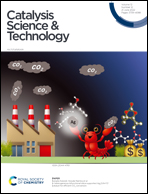Electroreduction of N2 to NH3 catalyzed by a Mn/Re(111) single-atom alloy catalyst with high activity and selectivity: a new insight from a first-principles study†
Abstract
First-principles calculations were employed to evaluate the doping effects on the activity and selectivity of various single-atom alloy (SAA) catalysts for the electrocatalytic nitrogen reduction reaction (eNRR). A series of SAA catalysts are formed by the introduction of different single transition metal (TM = Cr, Mn, Fe, Co, Ni, Cu, Mo, Tc, Ru, Rh, Pd, Ag, W, Os, Ir, Pt, and Au) atoms into a defective Re(111) surface. Our periodic density functional theory (DFT) calculations show that the Mn/Re(111) SAA has the ability to spontaneously adsorb N2 molecules rather than H atoms, and thus it can effectively improve the selectivity of the eNRR and inhibit that of the HER. Electronic structure analysis shows that hydrogenation of *N2 to *NNH on the surface of the Mn/Re(111) SAA catalyst results in the formation of a *N2−˙ radical via the charge transfer from the H atom to the adsorbed N2 molecule. Due to the very high reactivity of the *N2−˙ radical, the calculated free energy changes of the subsequent hydrogenation processes along the favorable distal pathway are close to 0 eV or even negative on the surface of the Mn/Re(111) SAA. All these results indicate that the Mn/Re(111) SAA may be an excellent catalyst with high activity and selectivity for the eNRR.



 Please wait while we load your content...
Please wait while we load your content...